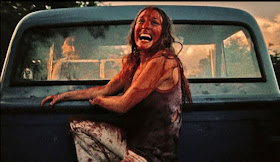Diabolique (Les Diaboliques) (1955): Only in France would a man’s wife and mistress team up to do him in. But it’s what happens next that makes Henri-Georges Clouzot’s black-and-white shocker most interesting. Véra Clouzot (who was married to the director at the time) and Simone Signoret drown Paul Meurisse’s character in the tub, then dump his corpse in the school pool. Instead of being discovered there, as they’d planned, the body goes missing—and eerie, impossible things start to happen. Seconds after the twist ending plays out, a warning appears: “Don’t be diabolical,” pleads the message, instructing viewers not to spoil the surprise for others. We wouldn’t dare, other than to say what makes the movie so effective even today is that audiences don’t know what they’re watching. Is it a murder mystery? A ghost story? No wonder Alfred Hitchcock wanted to make the movie himself—but Clouzot beat him to it.
Rosemary's Baby (1968): By the end of the 1960s, the idea that the devil was at large in the world didn’t seem like a far-fetched notion. Roman Polanski’s brilliantly disturbing thriller is rooted in a fearful vision of pregnancy but it also winks at a society that’s warming up to court the apocalypse. It’s the most intimate movie about Satan ever made. Mia Farrow, in a Vidal Sassoon haircut that becomes a ghoulish form of death-camp chic, gives a memorable performance as Rosemary, the innocent wife of an ambitious stage actor (John Cassavetes) who supposedly makes a deal with the cult of devil worshippers next door. They will summon Satan to make Rosemary pregnant, and he’ll get the career he wants. Ruth Gordon, as the devil’s noodge who assigns herself to look after Rosemary, personifies the banality of evil, and the film generates such supreme paranoia and suspense that it stands as one of the last great pieces of classical movie-making to emerge from the New Hollywood.
Psycho (1960): Alfred Hitchcock’s greatest film is such a landmark of cinematic horror that it’s almost hard to believe how it was greeted in 1960: as an effective but decidedly low-rent affair, a kind of sordid fun house. Sixty-four years later, there’s a reason that every detail and motif of “Psycho”—birds, drains, eyes, windshield wipers, stairway, swamp, madly shrieking violins, not to mention Mrs. Bates’ Victorian-bunned head—is nothing less than iconic. Hitchcock took his TV crew and made a trapdoor Gothic mystery of primal terror that invites us to watch ourselves watching it. In the film’s most famous scene (78 shots of agonizingly protracted living death), he pulled the plastic shower curtain out from under us so profoundly that it’s as if the movie were killing off not just Marion Crane but God himself: the sense, going forward, that anyone’s goodness would be not enough to protect them. The more you watch “Psycho,” the more you see that Anthony Perkins’ performance channels an instrospective terror for the ages.

The Exorcist (1973): William Friedkin’s film is about a twelve-year-old girl who either is suffering from a severe neurological disorder or perhaps has been possessed by an evil spirit. Friedkin has the answers; the problem is that we doubt he believes them. We don’t necessarily believe them ourselves, but that hardly matters during the film’s two hours. If movies are, among other things, opportunities for escapism, then “The Exorcist” is one of the most powerful ever made. Our objections, our questions, occur in an intellectual context after the movie has ended. “The Exorcist” is one of the best movies of its type ever made; it not only transcends the genre of terror, horror, and the supernatural, but it transcends such serious, ambitious artistic efforts in the same direction as Roman Polanski’s “Rosemary’s Baby.” The film contains brutal shocks, almost indescribable obscenities. That it received an R rating and not the X is stupefying. The evil feels extreme to the viewer at times, but also it feels always believable. In this day and age, would you trust the Catholic Church to fix it?
The Texas Chain Saw Massacre (1974): Very few horror movies possess the quality of a true nightmare — that transcendently scary bad dream you can’t wake up from, because it feels like it’s really happening. Yet as more and more people have analyzed it, most critics and film buffs agree that “Texas Chain Saw” turned out to be a true masterpiece of terror. Tobe Hooper directed it with a lyrical suspense worthy of an existential grindhouse Hitchcock. He took the story of five post-hippie teenagers driving a van through the Texas wilds and turned it into a plunge into the American abyss.
The film’s central image is that of a mentally arrested mute named Leatherface, who wears a mask of human skin and wields a power tool that metes out torture and death. He’s the granddaddy of the slasher genre’s masked killers (Michael Myers, Jason Voorhees, Freddy Kruger), but those all operated out of rage. Leatherface was driven by something else—he was a butcher, going on a rampage that seemed to act out something larger than mere homicide. You could call it the slaughter of human empathy.
And there’s another reason “The Texas Chain Saw Massacre” has cast such a shadow over the last half-century of horror films. As much as “Psycho” or “The Exorcist,” it created a mythology of horror, one that feels even more resonant today than it did 50 years ago. The film channeled the descent of the American spirit that we can now feel all around us. In the end, what “Chain Saw” revels in with such disturbing atmosphere, and what makes it more indelible and haunting than any other horror film, is its image of madness as the driving energy of the world: Leatherface, swinging his chain saw around in front of the rising sun, his crazed dance of death not just a ritual but a warning—that the center will not hold. That something incredibly wicked will come soon. Source: variety.com








No comments :
Post a Comment